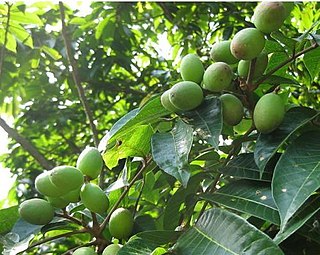
The Burseraceae are a moderate-sized family of 17-19 genera and about 540 species of flowering plants. The actual numbers differ according to the time period in which a given source is written describing this family. The Burseraceae are also known as the torchwood family, the frankincense and myrrh family, or simply the incense tree family. The family includes both trees and shrubs, and is native to tropical regions of Africa, Asia, Australasia, and the Americas.

Garuga is a genus of shrubs and trees in the family Burseraceae. Members are found in Asia and America.
Walsura is a genus of plants in the family Meliaceae.

Canarium album is a tree species in the genus Canarium and the family Burseraceae, found in Indo-China; the Catalogue of Life does not record any sub-species.

Spondias pinnata, sometimes also known as hog plum, is a species of tree with edible sour fruits. It is native to the Philippines and Indonesia, but has been widely naturalized in South Asia, Mainland Southeast Asia, Southern China, and the Solomon Islands. It belongs to the family Anacardiaceae. This species, among several others, has sometimes called the "wild mango" in other languages and was once placed in the genus Mangifera. It is found in lowlands and hill forests up to 1,200 m (3,900 ft).
Walsura robusta is a tree species described by William Roxburgh; it is included in the family Meliaceae. No subspecies are listed in the Catalogue of Life. In Vietnamese its name is lòng tong.

Protium serratum is a small-medium tree species in the genus Protium and the family Burseraceae. The Catalogue of Life does not record any subspecies.

Sterculia lanceifolia is a bush/tree species belonging to the genus Sterculia in the family Malvaceae. This species is found in Bangladesh, NE India, China and Indo-China and there are no subspecies listed in the Catalogue of Life.

Canarium pimela called Chinese black olive is a tree species in the genus Canarium and the family Burseraceae found in Indo-China; in Vietnam it is called trám đen or cà na. The Catalogue of Life does not record any sub-species. Once boiled in salt water the fruit are edible, resembling the flavor of salted plums, and are used in Chinese cuisine as a seasoning.
Phrynium imbricatum is a species of plant in the family Marantaceae. It can be found from India through to most of Indo-China; no subspecies are listed in the Catalogue of Life.
Uncaria acida is a species of liana in the family Rubiaceae.
Garuga pierrei is a tropical forest tree species in the family Burseraceae. It occurs in China and Indo-China; in Vietnam it may be called cốc đá or chua luy; no subspecies are listed in the Catalogue of Life.
Canarium subulatum is a tropical forest tree species in the family Burseraceae. It occurs in southern China and Indo-China; in Vietnam it may be called trám múi nhọn. No subspecies are listed in the Catalogue of Life.
Ablemothrips is a genus of thrips in the family Phlaeothripidae. It occurs in Asia, with two species recorded from Thailand and one species occurring in India, southern Japan, the Philippines, and Taiwan.
Adelphothrips is a genus of thrips in the family Phlaeothripidae. Species are known to occur on Java, Fiji and in the Philippines.
Agynaikothrips is a genus of thrips in the family Phlaeothripidae. It occurs in Asia, with one species known from Japan and the other from Taiwan.

Olax scandens is a species of epiphytic plant in the family Olacaceae. Its native range is India, Indo-China and Malesia, with no subspecies listed in the Catalogue of Life. Its name in Vietnamese is dương đầu leo or mao trật.
Ficus hederacea is a climbing fig species, in the family Moraceae, which can be found in the Himalayas, southern China and Indo-China. In Vietnam it may be called sung leo. No subspecies are listed in the Catalogue of Life.

Dracaena angustifolia is a species of Asian tropical forest under-storey plants in the family Asparagaceae; no subspecies are listed in the Catalogue of Life.

Erythrina stricta is a species of trees in the family Fabaceae identified by William Roxburgh in 1832. It is now placed in the subfamily Faboideae and the tribe Phaseoleae. This species has been recorded from the Indian subcontinent, Indochina and China. There is one valid variety: E. stricta var. suberosa.













